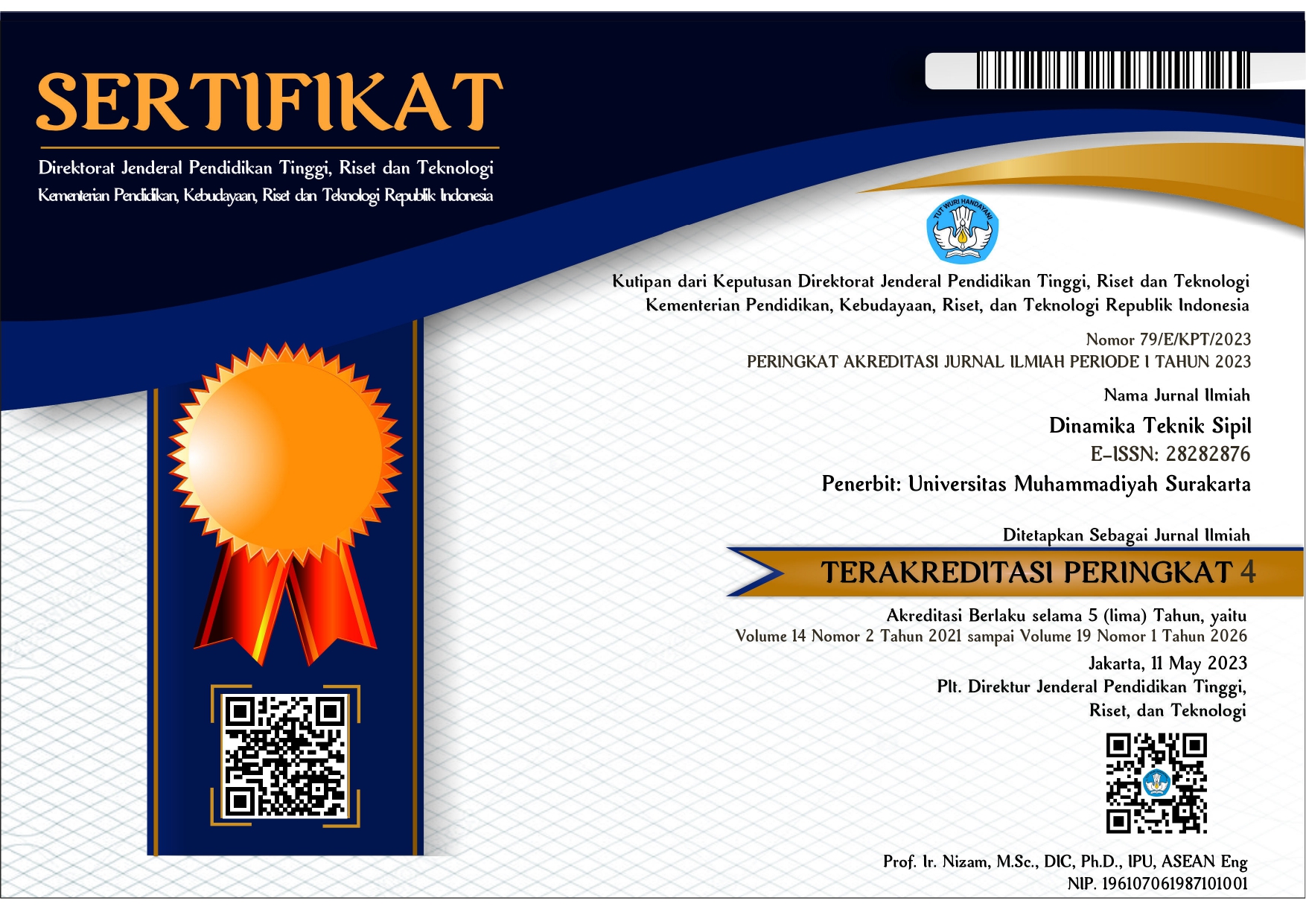Evaluation of Compressive Strength of Concrete with Replacement of Conventional Coarse and Fine Aggregates Using Palm Kernel Shell and Coconut Husk
DOI:
https://doi.org/10.23917/dts.v17i2.6167Keywords:
aggregate, coconut husks, compressive strength, concrete, palm kernel shellAbstract
Concrete is a widely used construction material, but its production has a negative impact on the environment. This study aims to determine the effect and optimal percentage of using palm kernel shells and coconut fiber in concrete mixtures on the compressive strength of concrete. The research method involved making a variety of concrete mixes with the replacement of conventional aggregates by palm kernel shells as coarse aggregate and coconut fiber as fine aggregate. Four mix variations were tested: A (1% coconut fiber, 5% palm kernel shell), B (2% coconut fiber, 5% palm kernel shell), C (1% coconut fiber, 10% palm kernel shell), and D (2% coconut fiber, 10% palm kernel shell). Compressive strength testing was conducted at 7, 14, and 28 days of concrete age. The analysis showed that variation A, with 1% coir and 5% palm kernel shell, produced the closest compressive strength to normal concrete. ANOVA tests confirmed the significant effect of these mixtures on compressive strength. The contribution of this research lies in the development of alternative concrete materials that are more environmentally friendly, utilizing agricultural waste to reduce dependence on natural resources and lower the carbon footprint of the construction industry.
Downloads
References
Alaneme, GU, Olonage AO, & Esenogho, E. 2023. Eco‑Friendly Agro‑Waste Based Geopolymer‑Concrete: a Systematic Review. Discover Materials. https://doi.org/10.1007/s43939-023-00052-8
Ananda, R. 2021. Pemanfaatan Serat Kelapa sebagai Alternatif Pengganti Kemasan Berbahan Plastik. J. Seni dan Reka Ranc. J. Ilm. Magister Desain 2, 1–14. Https://Doi.Org/10.25105/Jsrr.V2i1.10103
Ermawati, T. Saptia, Y. 2013. Kinerja Ekspor Minyak Kelapa Sawit Indonesia.
Haryanti, A. Norsamsi, N., Fanny Sholiha, P.S., Putri, N.P. 2014. Studi Pemanfaatan Limbah Padat Kelapa Sawit. Konversi 3, 20. Https://Doi.Org/10.20527/K.V3i2.161
Indahyani, T. 2011. Pemanfaatan Limbah Sabut Kelapa pada Perencanaan Interior dan Furniture yang Berdampak pada Pemberdayaan Masyarakat Miskin. Humaniora 2, 15. Https://Doi.Org/10.21512/Humaniora.V2i1.2941
Irahadi, D.R., Idawati, L., Simanjuntak, M.R.A. 2020. Pengukuran Emisi Gas Rumah Kaca dari Material Konstruksi Bangunan-Bangunan Gudang di Kabupaten Tangerang.
Marfranklin, M., Risdianto, Y., N.D. 2019. Pengaruh Penambahan Serat Sabut Kelapa pada Pembuatan Beton Ringan Cellular Lightweight Concrete.
Nakkeeran Ganasen, L. Krishnaraj, Kennedy C. Onyelowe, George Uwadiegwu Alaneme & Obeten Nicholas Otu. 2023. Soft Computing Techniques for Predicting the Properties of Raw Rice Husk Concrete Bricks Using Regression-Based Machine Learning Approaches. Scientific Report. https://doi.org/10.1038/s41598-023-41848-1
Nasution, L.M. 2017. Statistik Deskriptif 14.
Oktarina, D. 2018. Penggunaan Cangkang Kelapa Sawit Untuk Bata Beton Ringan 2.
Polii, R.A., Sumajouw, M.D.J., Windah, R.S. 2015. Kuat Tekan Beton Dengan Variasi Agregat yang Berasal Dari Beberapa Tempat di Sulawesi Utara.
Prahara, E., Liong, G.T., Rachmansyah, R. 2015. Analisa Pengaruh Penggunaan Serat Serabut Kelapa dalam Presentase Tertentu pada Beton Mutu Tinggi. Comtech Comput. Math. Eng. Appl. 6, 208. Https://Doi.Org/10.21512/Comtech.V6i2.2265
Premana, I.P.A., Kerdiati, N.L.K.R. 2022. Ashcrete Sebagai Material Bangunan Ramah Lingkungan. J. Vastukara J. Desain Inter. Budaya dan Lingkung. Terbangun 2, 203–211. Https://Doi.Org/10.59997/Vastukara.V2i2.1743
Raji, Mustapha A, Falola, BM, Enikuomehin, JT, Oyelade AO, Abiodun YO, Yusuf A. Olaniyi1, Olusola G. Olagunju, Kosisochukwu L. Anyaegbuna1, Musa O. Abdulkareem1 & Christopher A. Fapohunda. 2024. Prediction of Compressive Strength of Nano Silica and Micro Silica from Rice Husk Ash Using Multivariate Regression Models. AI in Civil Engineering. https://doi.org/10.1007/s43503-024-00043-5
Saputra, A., Oktarina, D., Gumay, A. 2022. Analisa Temperatur dan Waktu Terhadap Kuat Tekan dan Kuat Tarik Belah Beton Cangkang Kelapa Sawit Pasca Bakar 6.
Setyowati, E., Puspa D, A.P.D. 2019. Rekayasa Pengolahan Limbah Batok Kelapa sebagai Aksesoris Sanggul. J. Ilm. Pendidik. Tek. Dan Kejuru. 12, 118. Https://Doi.Org/10.20961/Jiptek.V12i2.34161
Siahaan, N.S.M., Sumajouw, M.D.J. 2020. Penggunaan Styrofoam sebagai Substitusi Parsial Agregat Kasar Terhadap Nilai Kuat Tekan dan Kuat Tarik Belah Beton Ringan.
Siswanto, J.E. 2020. Analisis Limbah Kelapa Sawit sebagai Bahan Bakar Boiler dengan Menggunakan Variasi Campuran antara Fiber dan Cangkang Buah Sawit. J. Electr. Power Control Autom. Jepca 3, 22. Https://Doi.Org/10.33087/Jepca.V3i1.35
Universitas Dharma Andalas, Vitri, G., Herman, H. 2019. Universitas Dharma Andalas. Pemanfaatan Limbah Kelapa Sawit sebagai Material Tambahan Beton. J. Tek. Sipil Itp 6, 78–87. Https://Doi.Org/10.21063/Jts.2019.V602.06
Vachlepi, A. 2015. Kajian Pembuatan Kompon Karet Alam dari Bahan Pengisi Abu Briket Batubara dan Arang Cangkang Sawit 26.
Wardanu, A.P. 2014. Strategi Pengembangan Agroindustri Kelapa Sebagai Upaya Percepatan Ekonomi Masyarakat di Kabupaten Ketapang 3.
Zalukhu, P.S., Irwan, I., Hutauruk, D.M. 2017. Pengaruh Penambahan Serat Sabut Kelapa (Cocofiber) Terhadap Campuran Beton sebagai Peredam Suara. J. Civ. Eng. Build. Transp. 1, 27. Https://Doi.Org/10.31289/Jcebt.V1i1.367
Downloads
Submitted
Accepted
Published
Issue
Section
License
Copyright (c) 2024 Firmanilah Kamil, Julyan Purnomo

This work is licensed under a Creative Commons Attribution-NonCommercial 4.0 International License.









